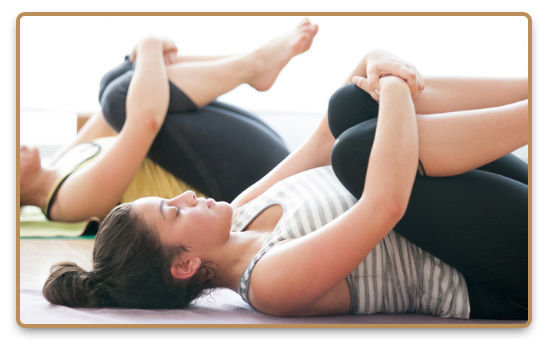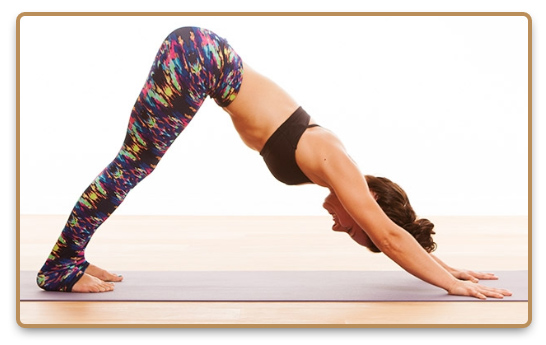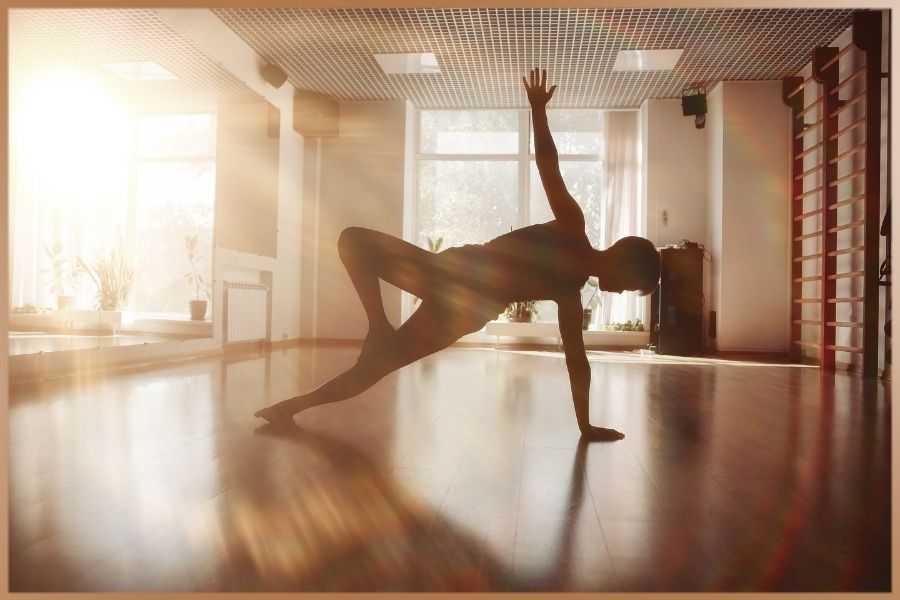
13 Sep Getting Started with Yoga as Exercise
It seems like everybody is doing yoga these days. Not only are in-person classes as popular as ever, but with the ascent of online yoga channels like Yoga with Adriene, Yoga with Kassandra, Aham Yoga, and Yoga Journal, it’s never been easier to start a yoga practice.
Yet, any look at the class programs at the local gym or studio will be a list of names, some of which you don’t even know how to say! Well, fear not. This is the guide for you.
We’ll go through a list of some of the most popular yoga for exercise styles, look at the history, the pros and cons, and help you pick the best fit. Just remember, for the most part, there are no good and bad styles of yoga, just ones that might not work for you. It is possible you may need to try a couple before you find the best one for your needs.
No matter what style you choose, it’s important to understand that yoga is much more than just stretching or exercise. The asana practice is only a small part of what is a comprehensive, multi-faceted belief system with the aim of helping one achieve enlightenment and a healthy lifestyle. It is possible to only utilize the exercise component as many in the West do, but to the full benefit of yoga it is encouraged to integrate all of the eight limbs of yoga into your life.
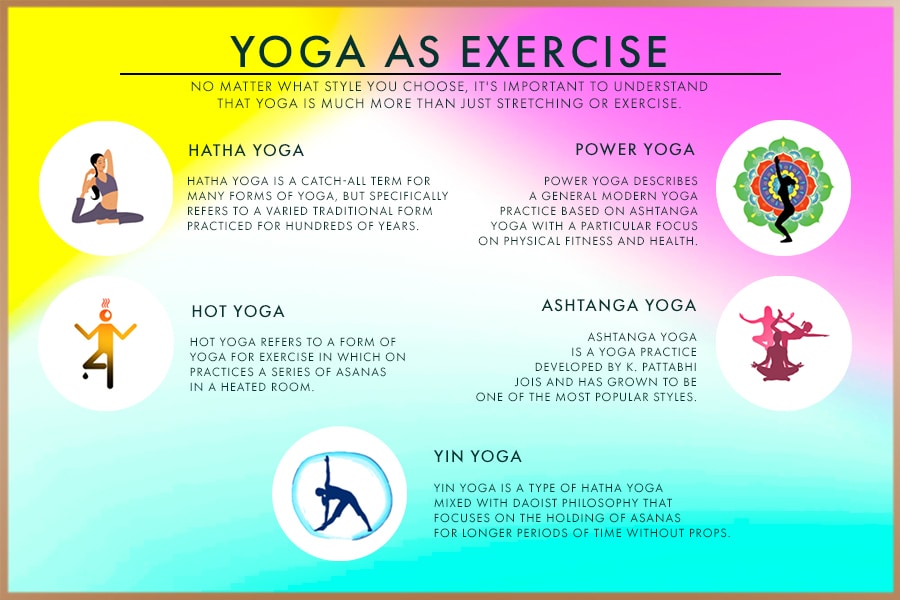
Hatha Yoga
What is it?
If there is any one label within yoga that is misused the most, it’s Hatha Yoga. In many ways, nearly every style we categorize as yoga today is some offshoot of hatha yoga. The term itself refers to the traditional belief system composed of the classical eight limbs: yamas (abstinences), niyama (observance), pratyahara (withdrawal), dharana (concentration), dhyana (meditation) and samadhi (absorption), pranayama (breathing), and asana (postures). Yet, it is the last of these that gets the most attention.
Most of the time, when you see “hatha yoga” written on a gym’s programs, that means that the class will move at a slightly slower pace and focus on holding asanas over transitions. Think something in between yin yoga and power yoga. These classes will typically employ a hybrid of different styles, or be something that doesn’t fit neatly into the other categories described below. In general, most of the famous youtube yoga personalities practice what is best called “hatha yoga”.
How did it start?
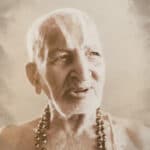
The traditional form of hatha yoga has been around for hundreds of years. Much of the practice is based on three main works Hatha Yoga Pradipika, Ghernada Samhita, and Siva Samhita. However, the teachings of these books hardly resemble what most people think of yoga today. The modern progenitor of hatha yoga is usually listed as Tirumalai Krishnamacharya, who expanded significantly the range of asanas and espoused the idea that yoga could be used as a form of exercise. He had a long list of influential followers, most famous of whom were K. Pattabhi Jois and B. K. S. Iyengar.
Pros
- Because most “hatha” yoga practices do not strictly adhere to the other yoga disciplines, it may be easier to find a class that is tailored to the students’ particular needs.
- As they often pick and choose elements from the yoga traditions, “hatha” yoga classes may be a good entry point as they are often less burdened by the weight of the yoga ideology.
Cons
- Because these break from the highly structured practices of some other styles, the quality of the classes may vary.
- It may lack some of the health benefits of more intense form of yoga.
Learn more about Hatha Yoga.
Power Yoga
What is it?
Power Yoga is currently one of the most popular styles of yoga in the world. Much of this is because it focuses almost entirely on the asana aspect of the practice. The main founders, Brian Kest and Beryl Bender Birch both deny that they de-spiritualized power yoga, claiming that the intention was never to separate the exercise component. Both recognize the importance of all eight limbs of hatha yoga, but make sure to emphasize that power yoga is foremost about physical health. No matter how you view it, if you see power yoga being offered at your gym, expect it to be a good workout.
How did it start?

Power yoga is not necessarily single discipline, but a collection of similar practices influenced by the teachings of K. Pattabhi Jois his Ashtanga yoga. It was founded independently of each other by two of his students Brian Kest and Beryl Bender Birch. They thought Jois’s practice was too rigid and was looking to create a style that was more accessible and focuses on fitness. Power yoga has since branched off into a variety of related styles including CorePower yoga and Rocket yoga.
Pros
- Of all the yoga styles out there, Power Yoga is among the best forms of exercise, showing notable benefit for flexibility, strength, stamina, and balance, plus can count as cardiovascular exercise in many cases.
- Since it is less laden with a lot of spiritual beliefs of other forms of yoga, it is a good practice for those who don’t buy the whole yoga ideology.
Cons
- Since it is a more strenuous form of yoga, Power Yoga can come with a higher chance of injury, especially for beginners. Much of this risk can be mitigated by having a strong teacher.
- Power Yoga has been criticized by yogis, most notably K. Pattabhi Jois, for its over-focus on physical fitness at the expense of other necessary areas like meditation.
Learn more about Power Yoga.
Hot Yoga (Bikram Yoga)
What is it?
Hot yoga (or Bikram Yoga) is a popular style of yoga for exercise that focuses on a series of asanas practiced in a hot humid room, typically 40C. The heat has been said to help increase flexibility, make the exercise more strenuous, and force the body to excrete toxins through sweat. Hot yoga is often considered a sub-style of power yoga.
How did it start?
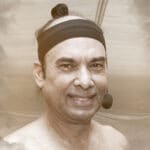
Hot yoga was originally developed by celebrity guru Choudhury Bikram in the early-1970s. He chose a particular set of 26 asanas which are meant to be done twice in succession, which he calls a “tune-up” for the body. Bikram chose 40C as a way to simulate the hot and humid environment of India where he originally learned yoga. For many years, this style of yoga bore his name, Bikram Yoga, but after multiple accusations of sexual misconduct, a number of studios adopted the term hot yoga to distance themselves from the disgraced yogi. It has since broken off into numerous other similar styles including Moksha yoga, Modo yoga, Baptiste Power Vinyasa, and Corepower Yoga.
Pros
- The practice of hot yoga has been linked to an increase in bone density and may help decrease cholesterol levels, in addition to the usual health benefits of a strenuous yoga practice.
- Due to the intense heat, the practice of hot yoga can leave people feeling especially refreshed and outwardly feels like a workout, which can be motivating to those who have a hard time seeing yoga as exercise.
Cons
- Because of the sweaty environment, hot yoga comes with an increased risk of injury from slipping. Therefore it is important to have proper non-slip mats and clothing that can absorb sweat.
- The heat of the hot yoga has led to some health problems from both dehydration and over-hydration after the practice. It is important to drink the proper amount of water and consult with your doctor before you begin any new exercise program, but this is especially important when beginning hot yoga.
Learn more about Bikram Yoga.
Ashtanga Yoga
What is it?
Ashtanga Yoga is a very popular and structured form of yoga. Despite the fact that it very explicitly focuses on all eight limbs of hatha yoga, Ashtanga yoga is most famous for its exercise aspect. The asana practice is a set sequence of postures divided into three levels. There are six sequences in total. One is meant to follow the sequence exactly for full benefit, and one cannot move onto the next one until they’ve mastered their current level.
Practitioners are expected to complete the sequence daily for maximum benefit. Most Ashtanga classes utilize the Mysore School of yoga teaching, where students are allowed to practice in the studio at their own pace, with a teacher nearby to help and adjust if needed. It is important to remember that Ashtanga Yoga is not intended to be a form of exercise, but the asana practice is a full workout in its own right.
How did it start?
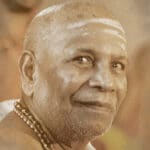
Ashtanga yoga was developed by K. Pattabhi Jois in Mysore, India. He mixed together a lot of the principles he read in the ancient texts with aspects of his tutelage by Krishnamacharya, who is considered the founder of modern yoga. He brought his style to the United States in the 1970s where its popularity exploded, fuelled by endorsements by celebrities such as Madonna and Sting. Ashtanga yoga has been extremely influential and many students of the style have developed their own offshoots such as Power yoga.
Pros
- Due to its highly structured nature Ashtanga yoga is a holistic practice with a myriad of benefits. The strict discipline needed may be motivating for people who need structure in their lives.
- The difficulty and concentration needed to complete the sequences used in Ashtanga yoga have been shown to have cognitive benefits in addition to physical ones.
Cons
- Ashtanga yoga can be quite difficult for many and comes with a risk of injury.
- With its focus on all eight-limbs and expectations of daily practice, Ashtanga yoga is not a good choice for people looking for a casual yoga practice or merely a workout.
Learn more about Ashtanga Yoga.
Yin Yoga
What is it?
Yin Yoga is a form of yoga as exercise that focuses on holding asanas for very long periods of time, sometimes as long as twenty minutes. Although the primary purpose of the practice is to increase joint flexibility so one can sit in meditation without discomfort, it does have the added benefit of being a light workout. It is meant to be done as a counter to “yang yoga”, which are the more active styles like power yoga or Ashtanga yoga. One can think of yang yoga as being exercise for the muscles and yin yoga is exercise for the joints and ligaments.
How did it start?

Most credit martial arts master Paulie Zink as the primary originator of the style, who looked to combine together the philosophies of Daoism and Hatha Yoga. He developed the style in the 1970s to help him with flexibility in his martial arts practice. However, it was one of his students, Paul Grilley, who brought the style to the masses. It has since become very popular.
Pros
- Because of the patience and mental focus needed to sit in yin yoga positions for such long periods, yin yoga in particular is said to be beneficial for mindfulness, stress relief, addiction issues, depression, and sleep problems.
- Most of the positions are supine or sitting, so people who struggle with balance issues may find yin yoga a bit less intimidating. It also comes with a lower risk of injury in comparison to other forms of yoga as exercise.
Cons
- Yin yoga is a slow paced practice, so unlike some of the others described in this article, there is very little cardiovascular benefit, nor significant strength building.
- Yin yoga is deceptive in its difficulty. Ultimately, it can be helpful for joint health, but with incorrect posture or too quick dynamic movements, there is a risk of injury to the fragile connective tissue of the body.
Learn more about Yin Yoga.
The Final Word
Whichever styles of yoga you choose, it can have a profound positive impact on your life. The health benefits have been shown in numerous studies, no matter which version you try.
Given the widespread options available, yoga is now accessible to almost anyone. So what are you waiting for? Get on the mat!
22 Sources +
Egely Wheel has strict sourcing guidelines and relies on peer-reviewed studies, academic research institutions, and medical associations. We avoid using tertiary references.
- A letter from Sri.K. Pattabhi Jois to Yoga Journal, Nov. 1995 – http://aylibrary.blogspot.com
- Yoga pioneer Pattabhi Jois dies – http://news.bbc.co.uk/
- Ashtanga Yoga Background – http://www.ashtanga.com/
- I read more than 50 scientific studies about yoga. Here’s what I learned. – http://www.vox.com/
- Ashtanga (eight limbs of yoga) – https://en.wikipedia.org/
- Ashtanga vinyasa yoga – https://en.wikipedia.org/
- Hatha Yoga – https://en.wikipedia.org/
- Tirumalai Krishnamacharya – https://en.wikipedia.org/wiki/Tirumalai_Krishnamacharya/
- Five-week yin yoga-based interventions decreased plasma adrenomedullin and increased – https://journals.plos.org/
- Yoga: a beginner’s guide to the different styles – https://www.theguardian.com/
- Yin yoga: be part of the yin crowd – https://www.theguardian.com/
- Ashtanga Yoga and Founder Pattabhi Jois – https://www.verywellfit.com/
- Most Popular Types of Yoga Explained – https://www.verywellfit.com/
- The 5 Pillars of Baptiste Power Vinyasa Yoga – https://www.verywellfit.com/
- What to Expect From a Hatha Yoga Class – https://www.verywellfit.com/
- Power Yoga History and Health Benefits – https://www.verywellfit.com/
- Introduction to Yin Yoga – https://www.verywellfit.com/
- Why Yin Yoga Could Be the Refresher Your Practice Needs – https://www.yogajournal.com/
- Power Yoga- https://www.yogajournal.com/
- Why Try Yin Yoga?- https://www.yogajournal.com/
- Larry Schultz- https://www.yogitimes.com/
Discover more types of Yoga
Zen Yoga
Zen yoga is a holistic yoga practice that blends together hatha yoga with an increased focus on Buddhist philosophies. Learn more...
Yin Yoga
Yin yoga is a type of hatha yoga mixed with daoist philosophy that focuses on the holding of asanas for longer periods of time without props. Learn more...
Vinyasa Yoga
Vinyasa yoga is a term used to describe a variety of yoga styles that utilize continuous movement instead of holding positions for long periods. Learn more...


